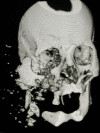Maxillofacial trauma patient: coping with the difficult airway
- PMID: 19473497
- PMCID: PMC2693512
- DOI: 10.1186/1749-7922-4-21
Maxillofacial trauma patient: coping with the difficult airway
Abstract
Establishing a secure airway in a trauma patient is one of the primary essentials of treatment. Any flaw in airway management may lead to grave morbidity and mortality. Maxillofacial trauma presents a complex problem with regard to the patient's airway. By definition, the injury compromises the patient's airway and it is, therefore, must be protected. In most cases, the patient undergoes surgery for maxillofacial trauma or for other, more severe, life-threatening injuries, and securing the airway is the first step in the introduction of general anaesthesia. In such patients, we anticipate difficult endotracheal intubation and, often, also difficult mask ventilation. In addition, the patient is usually regarded as having a "full stomach" and has not been cleared of a C-spine injury, which may complicate airway management furthermore. The time available to accomplish the task is short and the patient's condition may deteriorate rapidly. Both decision-making and performance are impaired in such circumstances. In this review, we discuss the complexity of the situation and present a treatment approach.
Figures




Similar articles
-
Airway Management of the Patient with Maxillofacial Trauma: Review of the Literature and Suggested Clinical Approach.Biomed Res Int. 2015;2015:724032. doi: 10.1155/2015/724032. Epub 2015 Jun 16. Biomed Res Int. 2015. PMID: 26161411 Free PMC article. Review.
-
Airway management in patients with maxillofacial trauma - A retrospective study of 177 cases.Saudi J Anaesth. 2011 Jan;5(1):9-14. doi: 10.4103/1658-354X.76476. Saudi J Anaesth. 2011. PMID: 21655009 Free PMC article.
-
Difficult Mask Ventilation in Penetrating Facial Trauma Due to Animal Attack: A Unique Challenge in the Emergency Department.Cureus. 2022 Apr 4;14(4):e23831. doi: 10.7759/cureus.23831. eCollection 2022 Apr. Cureus. 2022. PMID: 35530820 Free PMC article.
-
Airway management in maxillofacial trauma.J Anaesthesiol Clin Pharmacol. 2021 Jul-Sep;37(3):319-327. doi: 10.4103/joacp.JOACP_315_19. Epub 2021 Oct 12. J Anaesthesiol Clin Pharmacol. 2021. PMID: 34759538 Free PMC article. Review.
-
[Use of the laryngeal mask in difficult intubation].Anaesthesist. 1993 Sep;42(9):644-7. Anaesthesist. 1993. PMID: 8214537 German.
Cited by
-
A Case Report of a Transected Carotid Artery Caused by a Stab Wound to the Neck.J Educ Teach Emerg Med. 2021 Jan 15;6(1):V15-V18. doi: 10.21980/J8BP8M. eCollection 2021 Jan. J Educ Teach Emerg Med. 2021. PMID: 37465536 Free PMC article.
-
Adult face mask for inhalational induction in a child with maxillofacial injury.Anesth Essays Res. 2012 Jul-Dec;6(2):215-7. doi: 10.4103/0259-1162.108338. Anesth Essays Res. 2012. PMID: 25885622 Free PMC article.
-
Failed Mask Ventilation due to Air Leakage around the Orbit in a Patient with a History of Radical Maxillofacial Surgery with Orbital Exenteration.Turk J Anaesthesiol Reanim. 2016 Dec;44(6):317-319. doi: 10.5152/TJAR.2016.68889. Epub 2016 Dec 1. Turk J Anaesthesiol Reanim. 2016. PMID: 28058144 Free PMC article.
-
Comparing diagnosis of midfacial fractures by radiologists and plastic surgeons.Emerg Radiol. 2022 Jun;29(3):499-505. doi: 10.1007/s10140-022-02036-2. Epub 2022 Mar 10. Emerg Radiol. 2022. PMID: 35266070
-
Airway management in maxillofacial trauma: do we really need tracheostomy/submental intubation.J Clin Diagn Res. 2014 Mar;8(3):77-9. doi: 10.7860/JCDR/2014/7861.4112. Epub 2014 Mar 15. J Clin Diagn Res. 2014. PMID: 24783087 Free PMC article.
References
-
- American College of Surgeons Committee on Trauma . Advanced Trauma Life Support for Doctors ATLS. 7. Chicago, IL; American College of Surgeons; 2004.
LinkOut - more resources
Full Text Sources

